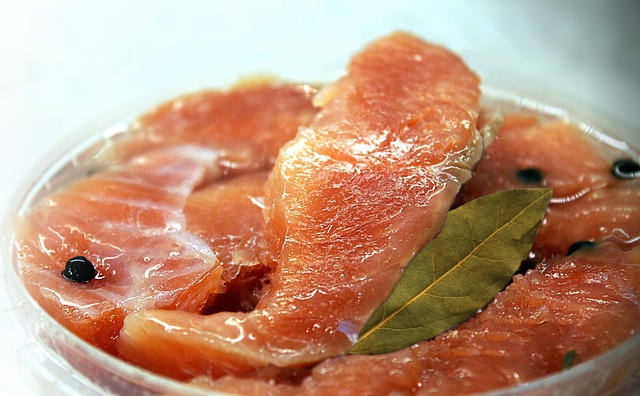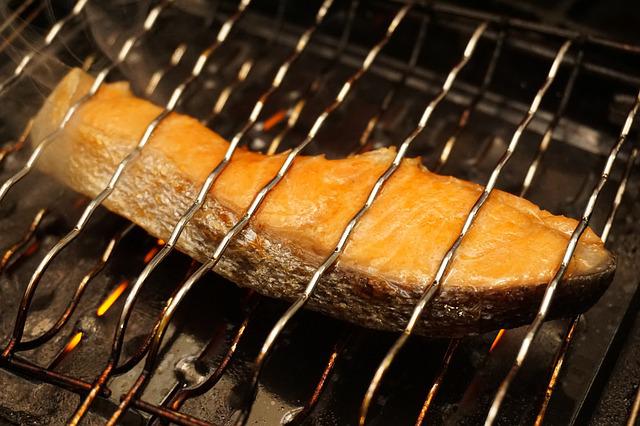Salmon is an excellent supply of animal protein, an almost perfect source of omega-3s (as found in most fish oil capsules), and a good source of protein, vitamin B, calcium, potassium, and antioxidants.
It has lower calories and saturated fats than most red meats, and it contains no carbohydrates, fiber, or sugar.
What Are the Five Salmon Varieties?
Salmon, believe it or not, comes in five varieties. (There are seven overall types, but you’ll only find five in the United States.) They might be little and weigh about five pounds, or they can grow to be massive and weigh over 126 pounds!
Depending on the season, some dwell in freshwater, some in saltwater, and others in both. The five primary types of salmon are all Pacific varieties.
- Sockeye salmon is a red-colored fish that is also lower in fat than other types. It’s a popular and flavorful cultivar.
- King or Chinook salmon is extremely heavy in fat and quite expensive. This fish is likely to be found only in high-end fish shops or fine dining establishments. It has a pleasant texture or mouthfeel.
- Pink salmon is a tiny and pale. This type is commonly used in the canning process and is what you’ll find in cans.
- Chum salmon is most well-known for its roe or eggs. They’re the kind of eggs you’d find in sushi rolls. I think the name is disgusting and would not buy it on its own, but you shouldn’t judge a fish by its name.
- Coho salmon is a popular form of fish that has a milder flavor than other types. It’s silver in color and you see in photographs of fishermen holding up a massive salmon for photographers.

How to Buy Salmon
- It’s simple to find good salmon. Simply follow these fundamental guidelines:
- Make sure it doesn’t smell fishy if you can smell it. Fresh salmon should not have a fishy odor.
- Fresh fish with brown spots or bruises should be avoided.
- The flesh should be brightly pigmented and not anemic or pallid in appearance.
- If you buy frozen or pre-packaged salmon, be sure the packaging is tightly sealed and not cracked or open in any way.
- If you’re not certain, read the label and avoid anything that says “color-added” or has a long list of ingredients.
- If a fishmonger is available, you may always ask for assistance on the many species of salmon.
The Ideal Baking Temperature for Salmon

Oven-baked salmon is done when the internal temperature reaches 110 to 140 degrees in the thickest part of the flesh. This temperature is normally reached by baking or grilling for four to six minutes per side. It can be cooked to medium-rare to medium-well doneness.
Suggestions for Perfectly Baked Salmon
- If you cook oven-baked salmon at too high or too low a temperature, it may dry out. You may keep the salmon wet by covering it as it cooks.
- Maintain the skin to create a natural barrier between the fish and the heat source/dish, which will assist keep the moisture in the salmon.
- Cooking salmon over gentle, low heat yields the best results every time and keeps it from drying out.
- Salmon takes around 12-15 minutes to cook in the oven. Any more than that, and it will be dry and overcooked.
How to Keep and Reheat
- It is simple to store a piece of filet. Simply place it in an airtight container or tightly wrapped in aluminum foil in the refrigerator. It will last about 3-4 days.
- Warm oven-baked salmon slowly and gently, adding a dash of water for extra moisture.
- I also like to reheat all varieties of salmon in the oven or on the stovetop rather than microwaving because microwaving tends to dry flesh out faster when reheating.
This is the finest Easy Healthy Baked Salmon ever!
This delectable salmon recipe, made with lemon and garlic for great flavor and baked in the oven for flaky tenderness, is the answer to busy nights and special events alike!
Ingredients Required
- Salmon Filets – Select filets that are pink and juicy. Alternatively, get vacuum-sealed frozen filets with no freezer burn.
- I recommend extra virgin olive oil, but any sort will do. You can also use vegetable oil instead.
- Kosher salt works well; I also like Himalayan pink salt.
- Cracked black pepper – I tend to overdo it, but remember to start with a small amount and taste before adding more.
- Minced Garlic – Store-bought minced garlic in oil is excellent, or you may mince your own.
- Italian Herb Seasoning Blend – You can use any well-known brand or build your own. In this recipe, don’t scrimp on the aromatic tastes of Italian seasonings.
- Lemon – A medium-sized lemon would suffice here, but if you enjoy the sour tartness of extra lemon, get a larger one.

Step-by-Step Instructions
- You should preheat the oven to 400°F and lightly butter a large baking pan.
- Season the filets liberally with salt and pepper and place them on a baking sheet.
- Combine the olive oil, garlic, herbs, and 1/2 lemon juice in a mixing bowl.
- Spoon this sauce over filets, making sure to spread it all over the tops and sides to avoid dry patches.
- Thinly slice the remaining 1/2 lemon and place a slice on top of each piece.
- Salmon should be baked for 15-18 minutes, or until it turns opaque and flaky when torn apart with a fork. If you like, you can broil for the last 1-2 minutes.
- If preferred, garnish with fresh thyme or parsley before serving.
BAKED CUSTOMIZATIONS
If you want to spice up this baked recipe, consider the following variations:
To give the salmon and asparagus a wonderful crunchy coating, combine a cup and a half of panko breadcrumbs with the parmesan cheese before sprinkling over and baking. This goes for any veggies you want to accompany the main dish.
You might want to add some butter to get that buttery taste, but it might add more calories.
Spice up the Italian seasoning by adding red pepper flakes or smoked paprika.
We suggest smaller slices of broccoli or cauliflower, zucchini or yellow squash disks, bell peppers, and or any other vegetable of your choice will work.
Replace the Italian ingredients with Cajun seasonings!
To Conclude
Now you have some ideas on how to cook a delicious salmon dish. Let’s grab your wallet and head down to your local grocery store and get the dinner going!

